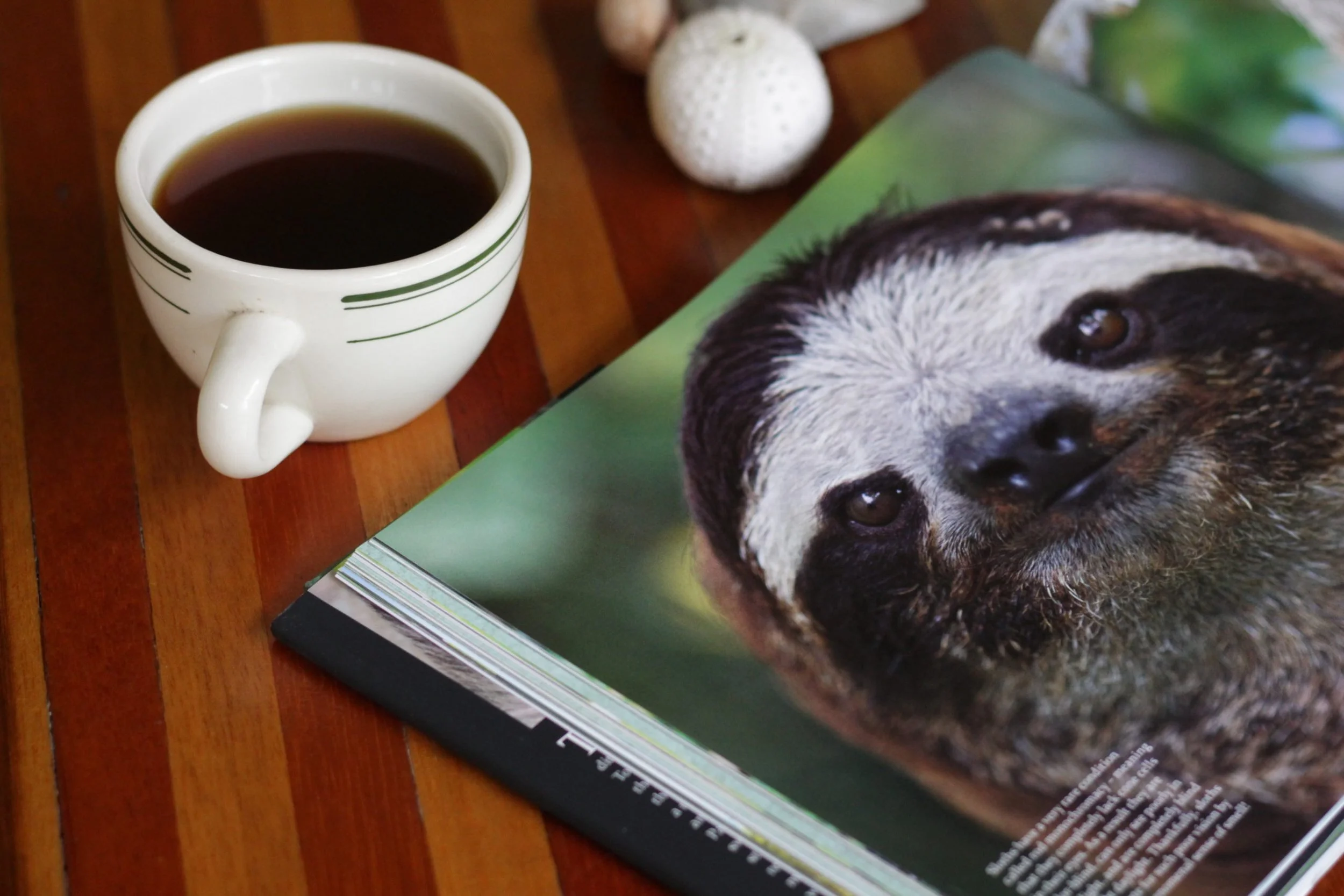

Become a sloth expert with The Sloths’ Encyclopedia! The Slothopedia is the ultimate sloth encyclopedia, offering detailed and up-to-date information on every aspect of sloth biology, behavior, and conservation. It’s a trusted resource designed to inspire curiosity and support efforts to protect these unique rainforest inhabitants.
What is a Sloth?
Sloths are tree-dwelling tropical mammals of Central and South America. They live in the rainforest canopy and are known for their slow and deliberate movements.
There are two living families of sloths: two-fingered and three-fingered. These families used to be called “two-toed” and “three-toed” but that was incorrect– all sloths have three toes on their hind limbs, only the forelimbs have different numbers of fingers.
Sloths are mysterious and unusual animals that scientists still know very little about. They have many adaptations that make them unique among mammals; they have a very efficient metabolism that is excellent at conserving energy, they are masters of disguise that can fool all the senses of their predators, and they are the slowest moving mammals on the planet: a sloth at top speed can cover only 1 meter in 1.5 seconds. That is only 1.5 miles per hour!
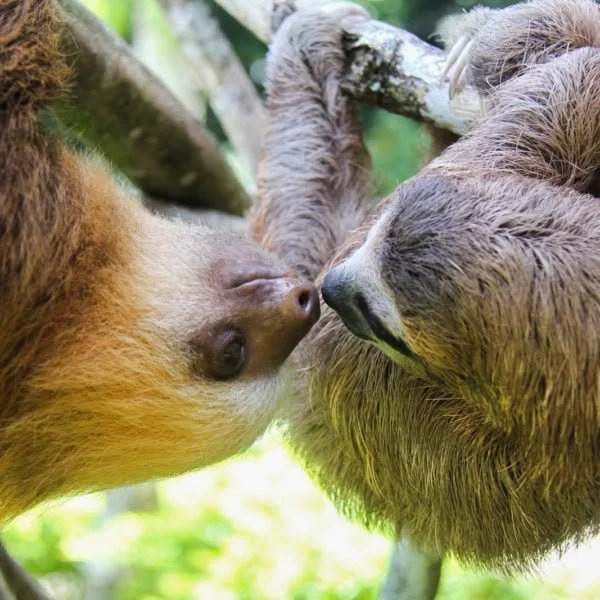
Most of what we think we know about sloths comes from sloths in zoos, but many animals live and behave very differently in captivity than they do in the wild. To study wild sloths in their natural environment, scientists must go deep into the jungles where they live and invent new ways to find and observe these enigmatic animals.
Jump To: Top, What is a Sloth?, Etymology and Naming, Phylogeny and Evolution, Taxonomy, Sloth Biology, Sloth Behaviors, Sloth Diet and Digestion, Reproduction and Lifespan, Habitat and Distribution, Survival Tactics, Sloth Conservation, Sloths and Human Relations, Sloths in Culture, Further Reading
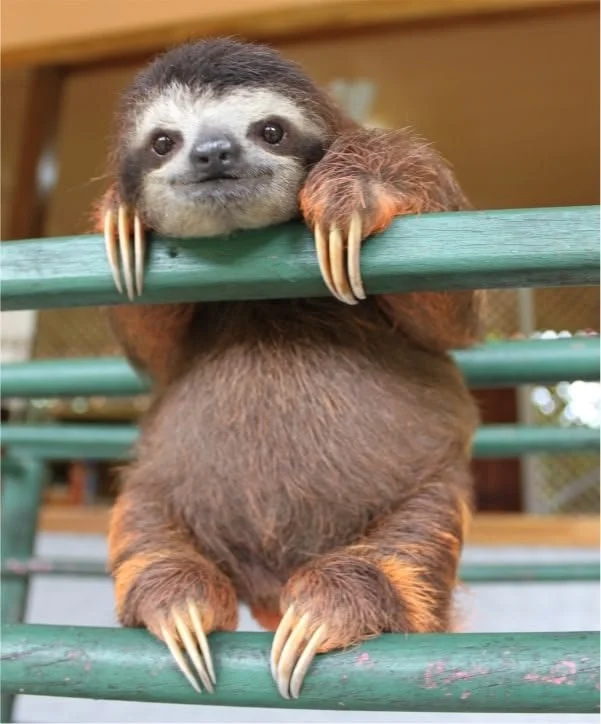
Etymology and Naming
The word “sloth” comes from the Middle English word slouthe or slewthe, meaning “laziness”, which comes from the Old English word slǣwþ meaning sloth, indolence, laziness, inertness, or torpor.
In 1749 the French Naturalist Georges Buffon described them thus:
“Slowness, habitual pain, and stupidity are the results of this strange and bungled conformation. These sloths are the lowest form of existence. One more defect would have made their lives impossible.”
In most languages the name for “sloth” is equivalent to some form of slowness, lateness, indolence, or laziness, leading to centuries of stereotyping sloths as creatures lacking in motivation.
Jump To: Top, What is a Sloth?, Etymology and Naming, Phylogeny and Evolution, Taxonomy, Sloth Biology, Sloth Behaviors, Sloth Diet and Digestion, Reproduction and Lifespan, Habitat and Distribution, Survival Tactics, Sloth Conservation, Sloths and Human Relations, Sloths in Culture, Further Reading
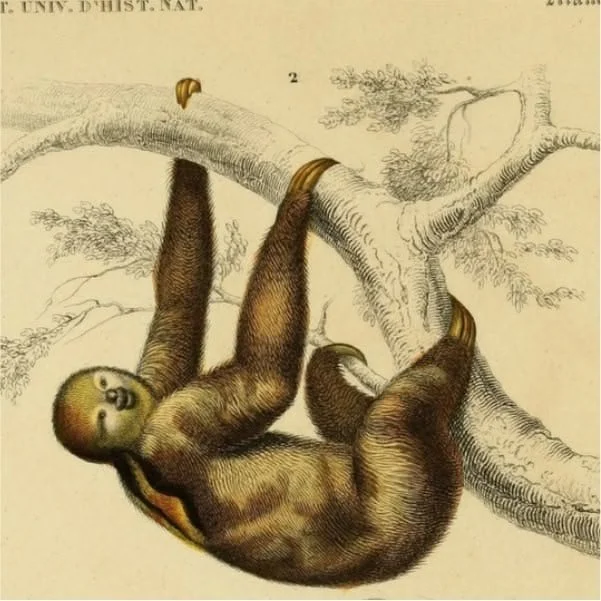
An illustration of a sloth from the Comte de Buffon’s ‘Histoire Naturelle’.
Phylogeny and Evolution
Today there are seven living species of tree sloth split between two very different genera: the three-fingered (Bradypus) and the two-fingered (Choloepus) sloths.

This classification represents current knowledge but may change subject to ongoing research.
Although often grouped together, research suggests that the two types of modern-day sloths are only very distant relatives separated by 30 million years of evolution, acquiring their unusual upside-down lifestyles separately.
As a result, two-fingered and three-fingered sloths are surprisingly different animals with very different lifestyles.
The Xenarthrans
The superorder Xenarthra contains sloths, anteaters, and armadillos.
The sloth’s closest relative is the anteater, followed by the armadillo. These three groups of animals combine to form the Xenarthra superorder which includes a grand total of 31 extant (still living) species.
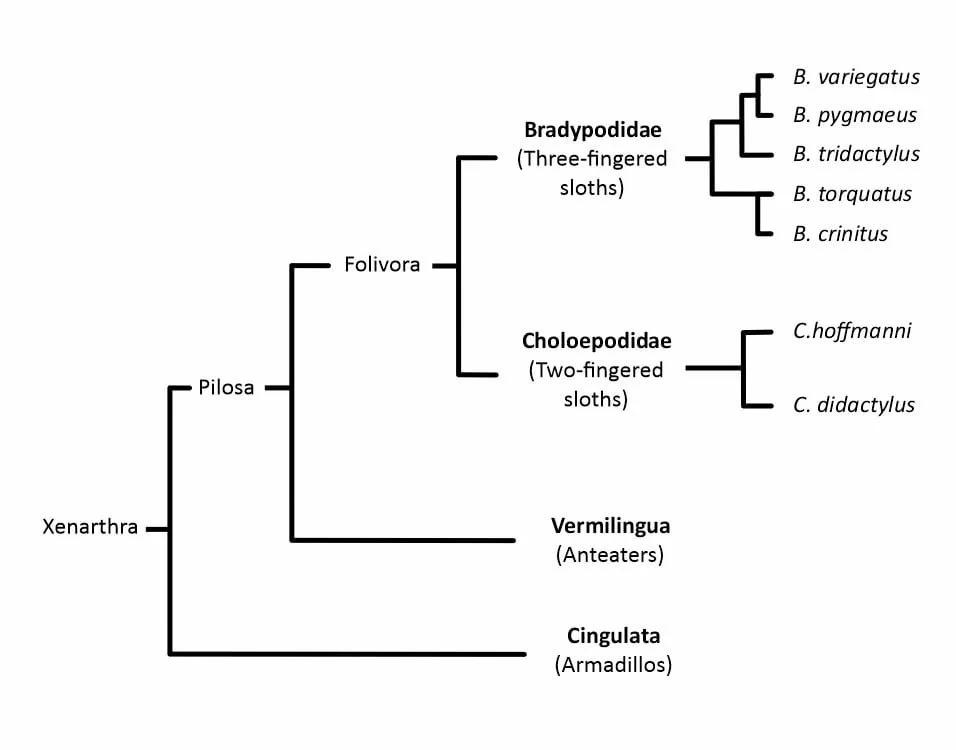
The xenarthrans are an odd order not closely related to other mammals. Xenarthra translates from Greek to “strange joints”, and they have unusual skeletons compared to most mammals.
Two-Fingered and Three-Fingered Sloths
Two-fingered and three-fingered sloths are very different animals with very different lifestyles. These discrepancies can be seen in the biology, ecology, and morphology of each genus.
There are five species of three-fingered sloth (Bradypus)
Brown-throated sloth (Bradypus variegatus)
Pygmy sloth (Bradypus pygmaeus)
Pale throated sloth (Bradypus tridactylus)
Northern Maned sloth (Bradypus torquatus)
Southern Maned sloth (Bradypus crinitus)
Molecular research has shown that the maned sloths split from the brown-throated and the pale-throated sloths over 12 million years ago, while the brown-throated and pale-throated diverged only 5-6 million years ago.
There are two species of two-fingered sloth (Choloepus)
Hoffmann’s two-fingered sloth (Choloepus hoffmanni)
Linnaeus’s two-fingered sloth (Choloepus didactylus)

Giant Sloths
Both the three-fingered and two-fingered tree sloths that we see today evolved from giant ground sloths, of which there were thought to be over 80 different kinds!
The largest of these was Megatherium, which weighed as much as an elephant and stood over 6 meters (18 feet) high. Thousands of ancient sloth burrow networks have now been discovered, the largest of which measures over 2000 feet long and is thought to have been dug out by many generations of extinct sloths.
Some ancient marine sloths even lived in the ocean, feeding from seagrass and seaweed in shallow water. Other giant ground sloths were covered in bony, armored plates, much like the armadillos of today.
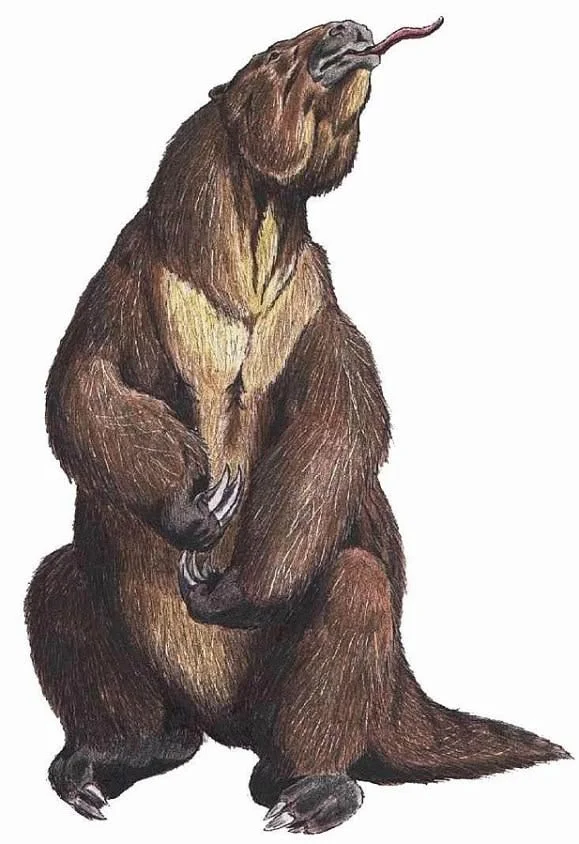
Extinction of the Mega Sloths
Megatherium, also known as M. Americanum, lived from the Early Pliocene through the end of the Pleistocene.
The only larger land mammals that existed during this time were the woolly mammoth and the giant rhinoceros.
These giants went extinct approximately 10,000 years ago, probably due to an expanding population of human hunters.
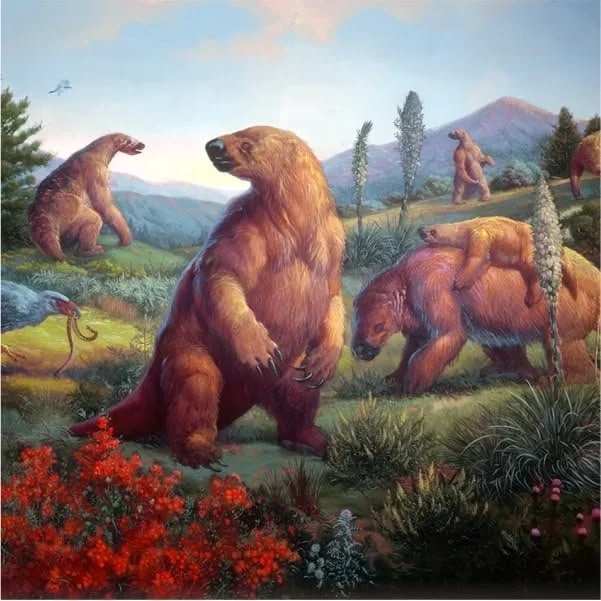
Jump To: Top, What is a Sloth?, Etymology and Naming, Phylogeny and Evolution, Taxonomy, Sloth Biology, Sloth Behaviors, Sloth Diet and Digestion, Reproduction and Lifespan, Habitat and Distribution, Survival Tactics, Sloth Conservation, Sloths and Human Relations, Sloths in Culture, Further Reading
Taxonomy
Although two-fingered and three-fingered sloths look and act similar they are not closely related to each other. Instead, they are examples of convergent evolution, which is when two different animals evolve similar traits to adapt to the same niche in an ecosystem.
Every aspect of both two- and three-fingered sloth biology is adapted to the common goal of saving energy.
Two-Fingered Sloths
There are two living species of two-fingered sloth, thought to have diverged 6-7 million years ago.
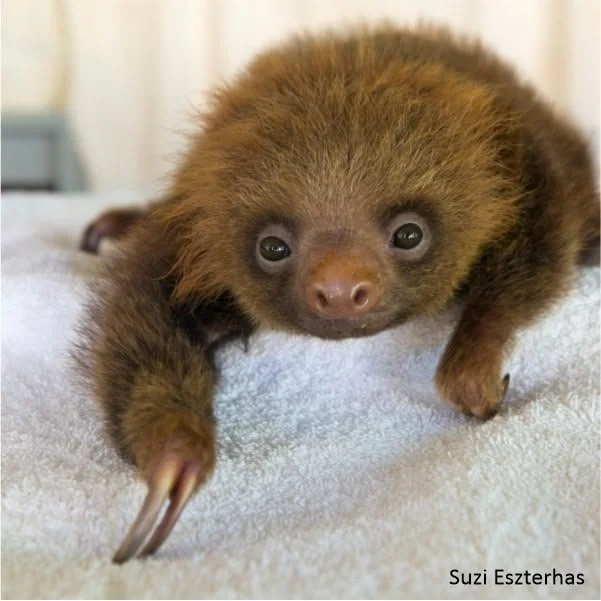
Two-fingered sloths are much larger than their three-fingered counterparts, reaching 80cm in length and weighing up to 11 Kg (although the average is 4-8 Kg).
They have a long, pig-like snout and can sweat only from the very tip of their nose. Like humans, they sweat when they are hot or stressed.
Their hands and feet have fleshy, hairless palms and soles.
They have long, brown hair which is lighter in coloration around the face, and can stand on end when threatened, helping to make the sloth appear larger.
Just like human hair, sloth hair comes in lots of different colors. Two-fingered sloths living in the hot lowland forests tend to have blonde hair, while those sloths living at higher altitudes typically have darker and thicker fur to cope with the colder climate. You can sometimes even see ginger sloths!
Two-fingered sloths are more active and generally faster-moving than three-fingered sloths. For a long time, it was thought that their activity was primarily nocturnal, but scientists are now learning that diurnal movements are also common in these species.
Two-fingered sloths have 46 ribs, more than any other mammal! For comparison, humans have 24 ribs, and whales only have 18. These extra ribs help support their stomach when hanging upside down, and are very flexible, making them hard to break. Sloths have been known to survive falls from nearly 30 meters (90 feet) up in the rainforest canopy.
Hoffmann’s Sloth (Choloepus Hoffmanni)
Conservation status: Least concern
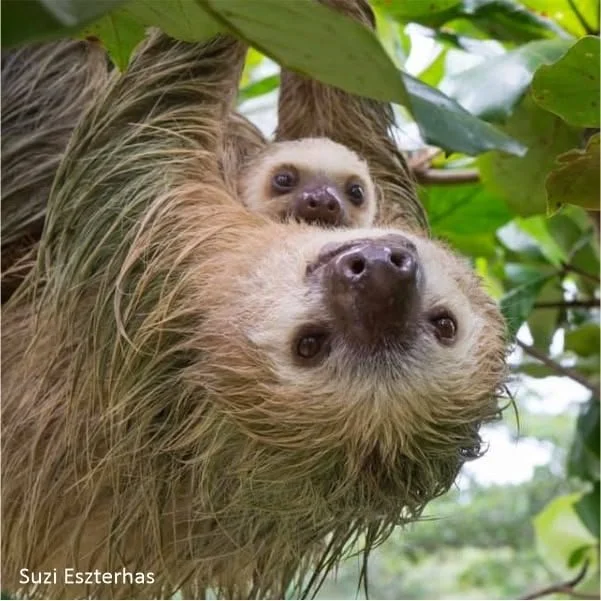
The Hoffmann’s two-fingered sloth can be found inhabiting tropical forests ranging from sea level up to an elevation of 3000 meters (9800 feet, or 1.8 miles).
There are two separate populations of C. hoffmanni on either side of the Andes mountain range. The most northern population ranges from eastern Honduras to western Ecuador, and the southern population ranges from eastern Peru to western Brazil and northern Bolivia.
These two populations are thought to have diverged up to 7 million years ago. There are 5 suggested subspecies.
Linnaeus’s Sloth (Choloepus Didactylus)
Conservation status: Least concern
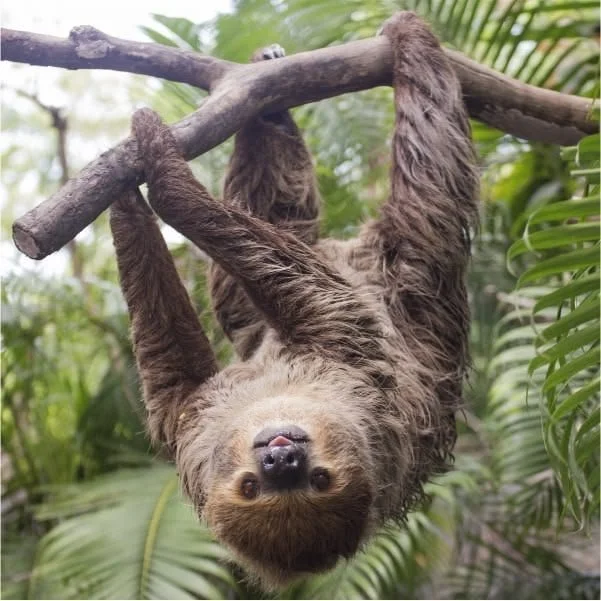
The Linnaeus’s two-fingered sloth is of similar appearance to C. hoffmanni, but has much darker coloration on the snout, hands, and feet.
This species ranges from Venezuela, the Guyanas, and Colombia to Ecuador, Peru, and Brazil north of the Amazon River. There is some evidence to suggest that they also extend into Bolivia.
This species of sloth is frequently maintained in zoological institutions worldwide due to the ease at which individuals can be exported from countries within its home range.
Three-Fingered Sloths
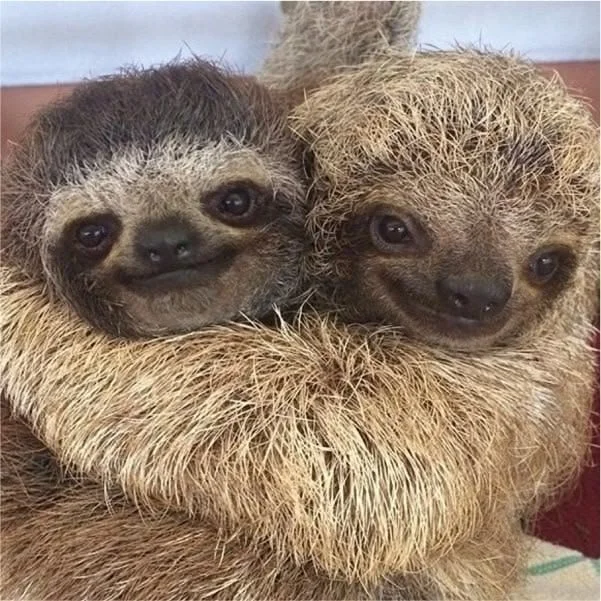
There are 4 living species of three-fingered sloths, all of which live within the forests of Central and South America where the tropical climate maintains relatively warm temperatures all year round.
The 4 species include:
Brown-throated sloth (Bradypus variegatus)
Pygmy sloth (Bradypus pygmaeus)
Pale throated sloth (Bradypus tridactylus)
Maned sloth (Bradypus torquatus)
Jump To: Top, What is a Sloth?, Etymology and Naming, Phylogeny and Evolution, Taxonomy, Sloth Biology, Sloth Behaviors, Sloth Diet and Digestion, Reproduction and Lifespan, Habitat and Distribution, Survival Tactics, Sloth Conservation, Sloths and Human Relations, Sloths in Culture, Further Reading
Sloth Biology
Morphology and Anatomy
Fur and Hair
Sloth fur is very important to their thermoregulation.
Sloth fur has two distinct layers: a soft, downy undercoat, which is important for warmth, and a coarse outer coat for camouflage.
The hair grows in the opposite direction to every other mammal, parting on the stomach and pointing toward the back. This peak of hair is called the drip tip, and it makes it easier for water to run off their body in heavy rain. Sloths groom their fur daily to keep it in good condition.
Sloth hair is specially adapted to allow the sloth to be a miniature, mobile ecosystem. Just as the forest is home to sloths, each sloth is home to a symbiotic variety of plants and animals.
Sloth fur contains micro-cracks which trap moisture for over 80 different kinds of algae and fungi. This algae turns the sloth fur green over time and helps the sloth blend into the rainforest canopy.
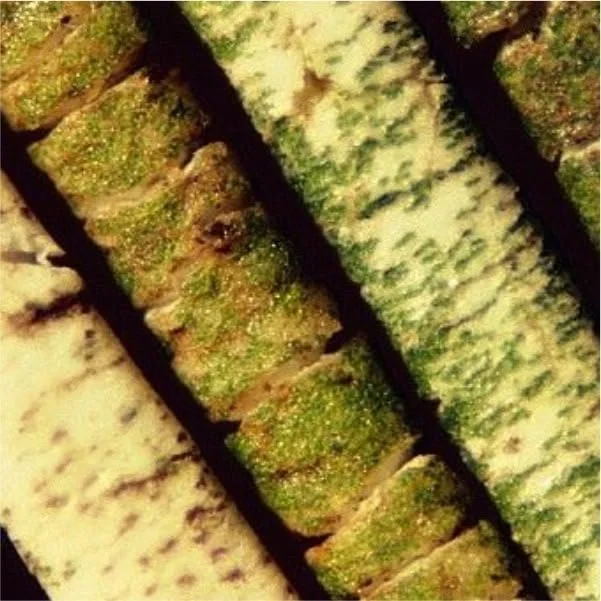
Additionally, their fur provides a habitat for a number of different invertebrates, including five different species of moths known as sloth moths (Pyralidae). These moths as well as many of the algae and fungi species found in sloth fur are not found anywhere else on the planet. They only live in sloth fur!
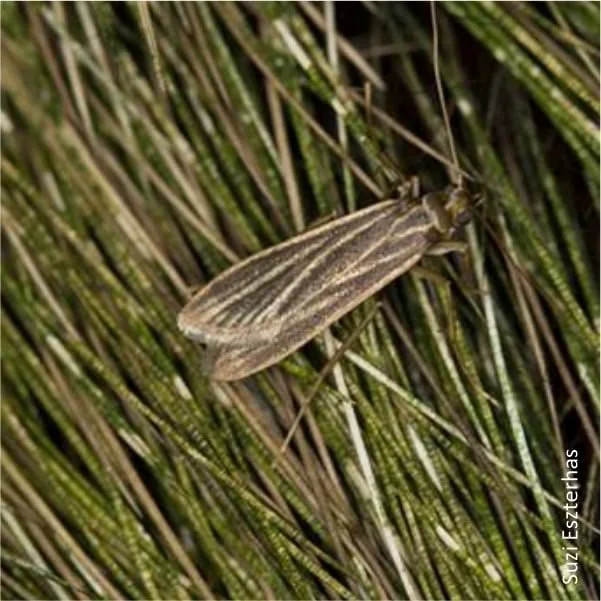
Sloths have a mutualistic relationship with the ecosystem living in their fur – this means that both the sloth and the organisms living on them benefit from the relationship. Sloths provide a home for their symbionts and the algae provide sloths with coloration and camouflage.
Although it was once believed that sloths eat the algae from their fur, scientists now know that this doesn’t happen.
Some of the fungi found on sloths have antibacterial properties and have been found to be active against some parasites and cancers. This might help sloths to resist certain diseases, and may also help other animals, including humans.
Teeth
Unlike human teeth, which have two layers (the inner dentin and the outer enamel), sloths have only the inner dentin. Without the protective enamel layer, sloth’s teeth absorb tannins from the leaves they eat and often turn black.

Sloths don’t have to worry about losing teeth as easily as humans because they are what are known as “hypsodonts”, which means their teeth grow continuously throughout their lives.
These continuously growing teeth without enamel are a characteristic shared by all Xenarthran mammals.
Three-fingered sloths have only a set of small, peg-like cheek teeth that are used for chewing leaves. Two-fingered sloths have the addition of large, sharp frontal teeth called ‘caniniforms’ (named because they resemble the typical canines of other mammals). The slight overbite causes the top pair to grow in front of the bottom pair and constantly rub against each other. Every time a two-fingered sloth opens its mouth their teeth self-sharpen!
Claws, Fingers and Nails
Sloths have long hook-like fingers and toes that allow them to hang suspended from a branch without using any energy. They can eat, sleep, and give birth in this position, sometimes even remaining like this after death.
Sloths’ claws are actually formed by the elongated and curved distal phalange bones protruding from their limbs. These bones are covered by a sheath of the same material that makes up our fingernails and hair (keratin).
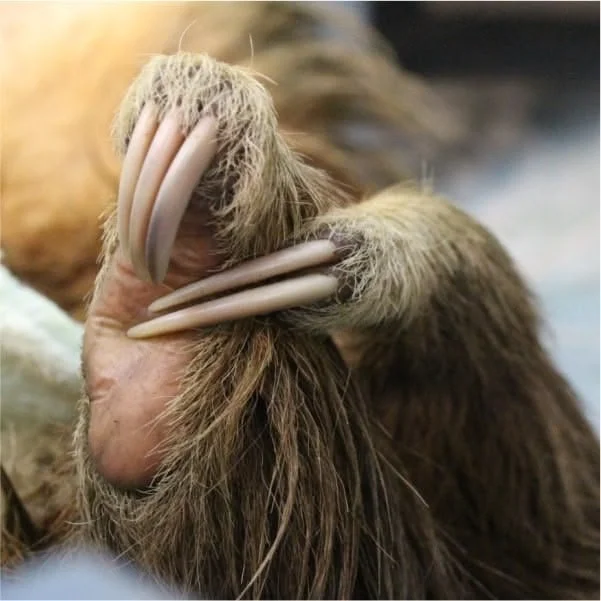
The nail grows continuously. In wild sloths the length of their nails is maintained through constant use; the nail is worn down while the sloth is hanging and climbing.
Captive sloths must have their nails trimmed regularly so that their fingers and toes do not become overgrown and disfigured.
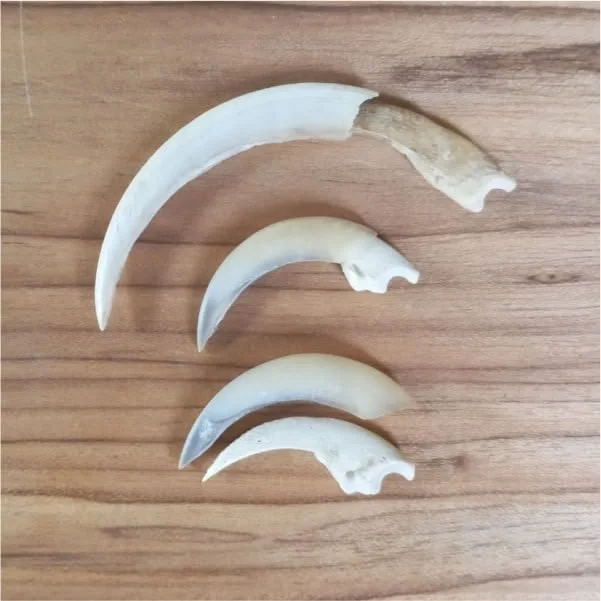
If they get broken or damaged, sloths can actually regrow their claws thanks to their low metabolic rate (in a similar way to when reptiles regrow their limbs).
However, the claws will rarely regain their original shape, often growing back deformed. In the wild, this can put the sloth at a great disadvantage as their claws are vital for life in the canopy.
Sloth Vision and Sense of Smell
All sloths have a condition called rod monochromacy—very rare among mammals– meaning that they completely lack cone cells in their eyes.
Since cone cells are what allow animals to see in color, sloths are color blind. They also don’t see very well in dim light and are completely blind in bright daylight.
Instead of using sight as a primary sense, sloths have an excellent sense of smell.
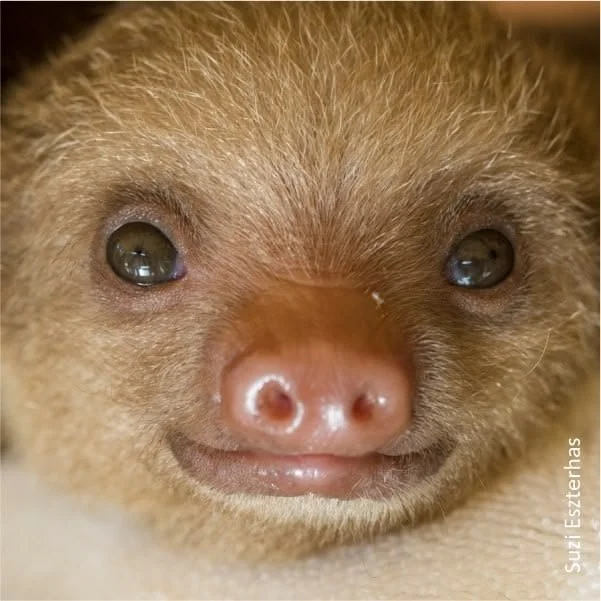
Stomach
Sloth’s stomachs are very large and have four chambers, the same as a cow. The partially digested leaves can account for up to 37% of a sloth’s weight!
A sloth’s esophagus does not go in a straight line from mouth to stomach, but instead has a loop in it. This enables the sloth to eat while hanging upside down without having gravity pull the food back out.
This loop also keeps sloth from being able to vomit—so they have to be very careful not to eat anything that makes themselves sick!
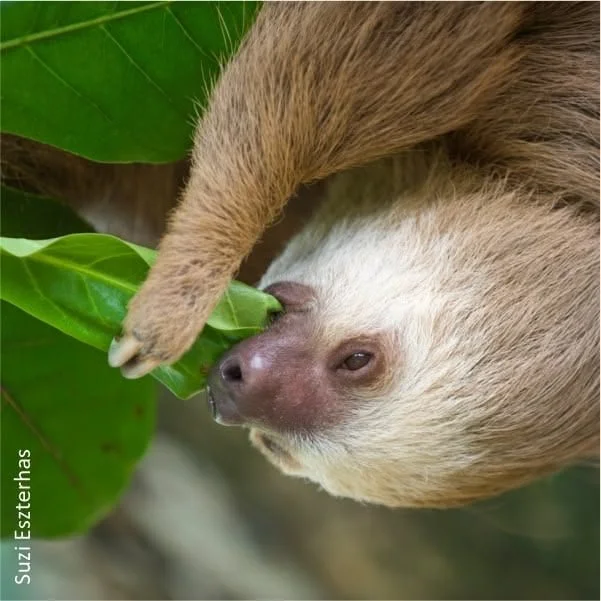
Fibrinous Adhesions
Sloths have unique attachments inside their bodies that help anchor their organs against their lower ribs. This helps their organs stay comfortably in place while hanging upside down, making it easy for the sloths to breathe. The presence of these adhesions reduces the amount of energy that sloths use each day by 7-13%.
Veins and Arteries
Specialized valves and sphincters within the sloth’s circulatory system ensure blood maintains constant pressure and direction, always flowing in the right direction at the right speed. This is important because sloths spend so much time hanging in unusual positions that they cannot rely on gravity to help blood flow.
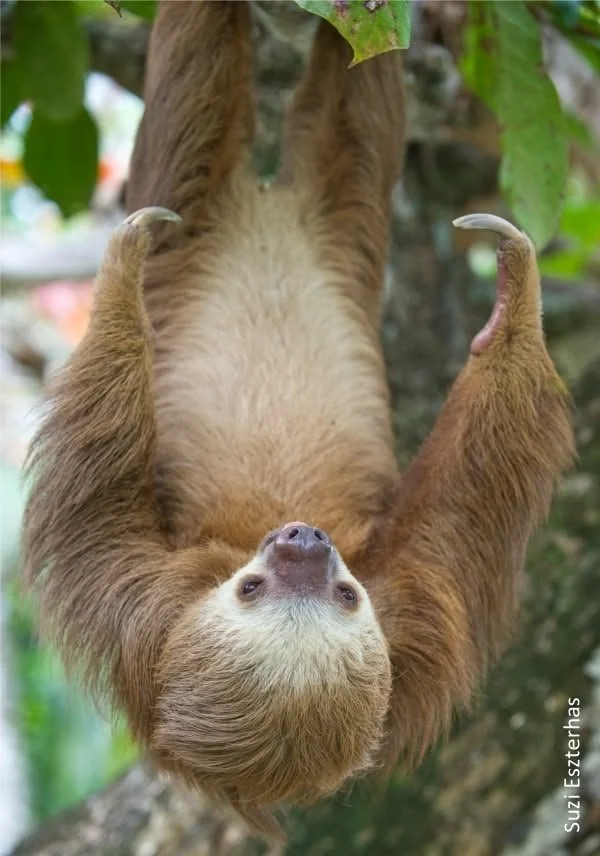
Sloth Muscles
Sloths are incredibly strong– approximately 3 times stronger than the average human being when it comes to grip strength, despite having 30% less muscle mass than other mammals of their size. Muscle tissue is very metabolically expensive, but sloths are all about saving energy, so sloth muscles work very efficiently.
The muscles that sloths use to grip and produce a pulling motion are much more prominent than those that produce a pushing motion because sloths primarily use their arms to pull themselves upwards or to pull branches towards the body.
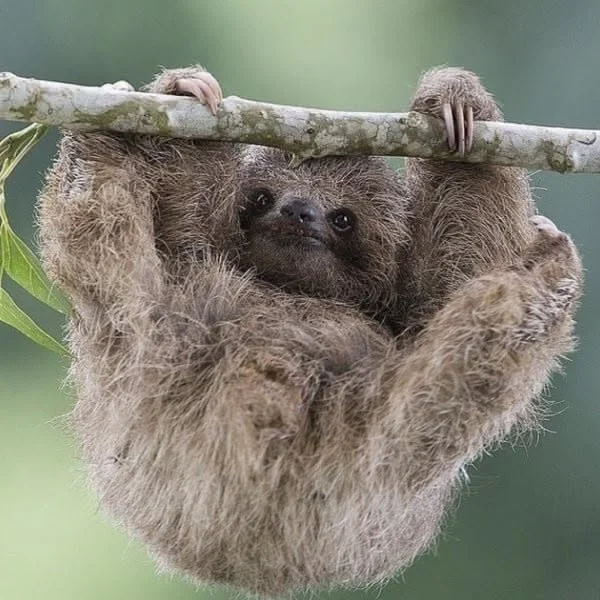
Fun fact – sloths have 52 muscles in one arm!
Sloth muscles are also predominantly made up of specialized slow-twitch fibers (also called type 1 muscles), and produce the slow, deliberate, and controlled movements shown by sloths.
Tail
Three-fingered sloths have small, stubby tails which are very strong – measuring approximately 6 – 7 cm (about 2.5 inches) long.
They use their tails as a brace while climbing and also to dig a hole before pooping.
Two-fingered sloths do not have a tail.
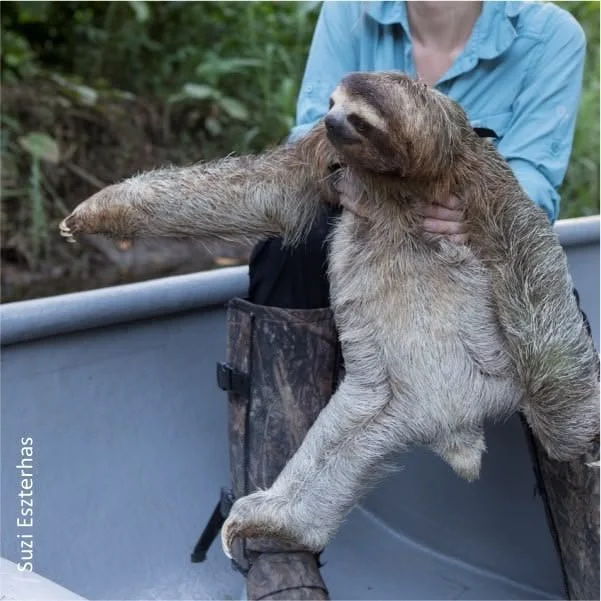
Sloth Moths
Sloth fur supports an entire mini-ecosystem, including several species of moths and beetles that are found nowhere else on earth!
A single sloth can host hundreds of moths which spend their entire life in the sloth’s fur, leaving only to lay eggs. These eggs are laid in the sloth’s feces when the sloth comes to the ground to poop.
After the eggs hatch the new moths either wait for the sloth to return, or fly up into the canopy to find a new sloth host.
Moth life-cycle:

Fun fact – A single sloth can host up to 950 moths and beetles within its fur.
Activity
Warm-blooded or cold-blooded?
Although sloths are mammals, they are what is known as Poikilotherms and do not regulate their temperature the way most warm-blooded animals do which helps them to save energy.
They live in tropical environments where it is warm all year round and maintain a thick coat of fur to assist in thermoregulation. The body temperature of sloths is very dependent on the surrounding environment, and if sloths get too cold they will stop digesting food and can die.
The average temperature of the three-fingered sloth is around 32.7℃ (91℉), compared to humans’ 36.5℃ (98.6℉). The sloth’s unusual muscle structure means that they cannot shiver to get warm.
As cold-blooded animals such as reptiles, sloths help control their body temperature by seeking warm and cool areas (such as basking in the sun or laying in the shade) or curling into a ball to conserve warmth.
Sloths’ core temperature may fluctuate up to 10℃ (18℉) over the course of the day.
Hanging
Sloth’s hands and feet are permanently curled into a hook-like arrangement and have very specialized muscles and tendons—this allows them to hang from any limb using almost no energy.
Sloths are so strong and so good at hanging onto branches that predators often cannot pull them off their trees.
Sloths are so well adapted to hanging from branches that they may continue to do so even after death. Wild sloths have sometimes been observed to die while hanging upside down on a tree branch and remain suspended by their long, curved fingers.
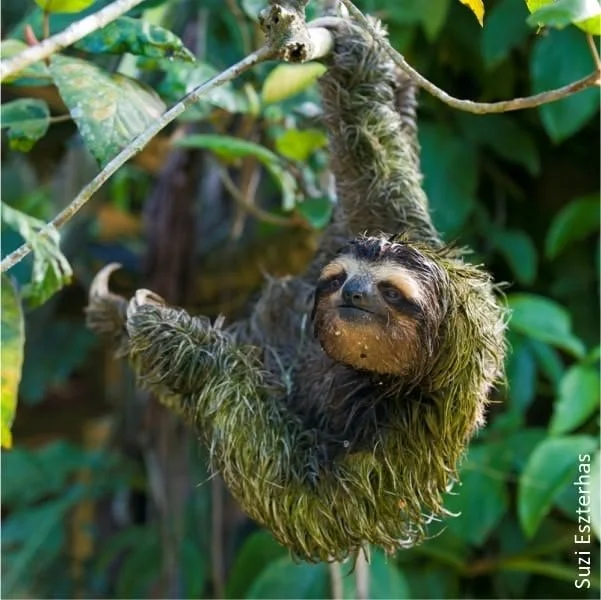
Sloth Speed
Sloths are very, very slow. At top speed, a sloth can cover approximately 1 meter in 1.5 seconds (approximately 1.5 miles per hour), but for a sloth, this is the equivalent of a sprint– tiring them out quickly and burning lots of energy. Sloths only move this fast in response to immediate danger.
Typically, a sloth will move upside down through the treetops at an average speed of 1 meter every 3 seconds (or about 1 foot per second, just over ½ of a mile per hour).
Although they move slowly, sloths have incredible stamina, and can stay on the move for surprisingly long periods of time. This allows them to cover large distances and find new territory.

Sloth Intelligence
How intelligent are sloths? This is a very poorly studied topic. It is true that sloths have small brains compared to their body size, however scientists are now realizing that this actually doesn’t relate to intelligence at all.
The brains of sloths might be small but they are very much focused on the specific skills that they need for survival. For example, the section of the brain that controls forelimb movement is well developed for careful climbing, and the sloth’s spatial memory is particularly impressive.
Having a good spatial memory is important for sloths as they have poor eyesight. They navigate around their home ranges using their memory and sense of smell. However, the sloth’s social skills and problem-solving abilities are somewhat lacking, which often leads to them being labeled as “stupid”.
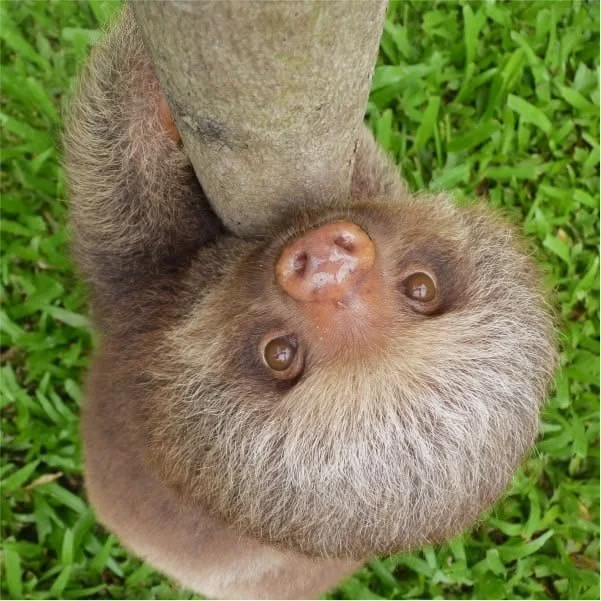
Jump To: Top, What is a Sloth?, Etymology and Naming, Phylogeny and Evolution, Taxonomy, Sloth Biology, Sloth Behaviors, Sloth Diet and Digestion, Reproduction and Lifespan, Habitat and Distribution, Survival Tactics, Sloth Conservation, Sloths and Human Relations, Sloths in Culture, Further Reading
Behavior
Sleeping
Sloths have the slowest metabolic rate of any non-hibernating land mammal. This sometimes makes people think that they are lazy, unmotivated, and not very good at what they do. In fact, being slow is an incredibly successful strategy for survival: sloths have survived on this planet for almost 64 million years!
Contrary to their reputation, sloths don’t sleep that much at all – research has shown that on average, wild sloths only sleep for 8-10 hours a day. In comparison, the similarly sized howler monkeys that sloths share their environment with sleep for 15 hours a day, while koalas will regularly snooze for 20 hours.
Cathemerality, sometimes called metaturnality, means that an animal sleeps at irregular intervals throughout the day. Sloths take short naps during the day and night, and spend the rest of their time feeding, grooming, moving, or observing their environment.
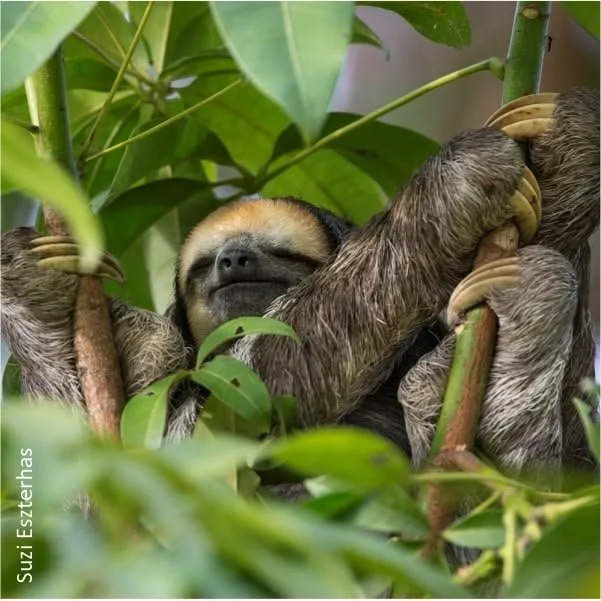
Toilet Habits
In an optimal environment with lots of trees, sloths don’t like to come down to the ground, and will only do so for one reason – to go to the bathroom. In the wild, they do this approximately once every 5 days, although in captivity they often do it more often.
Fun fact – sloths can lose up to one-third of their body weight in one toilet session!
No one knows why sloths come down to the ground to go to the bathroom – on the surface, this seems like a risky waste of energy when sloths’ entire lives revolve around conserving energy.
Scientists have a few hypotheses why sloths might have this unusual habit, such as: by only pooping on the ground, they avoid leaving a scent trail in the trees for predators, to help the sloth moths lay eggs and find new hosts, or to use pheromones in the feces to communicate with other sloths.
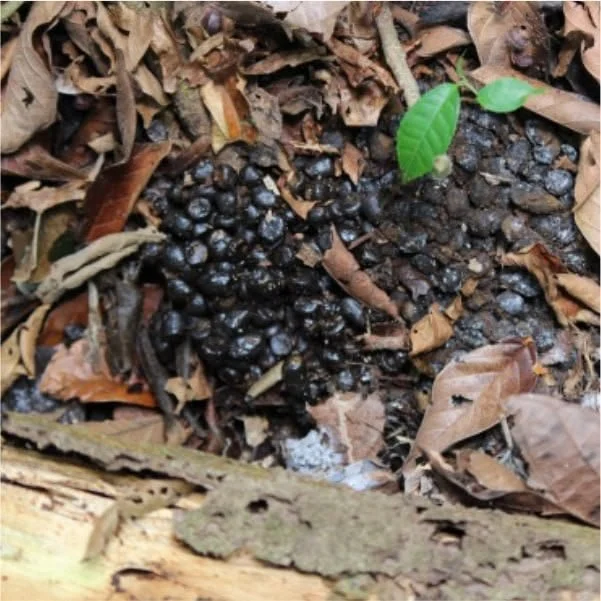
Sloths will often use the same tree, the picture shows old poop and fresh poop as demonstrate this.
If sloths left pheromone trails in the branches of the trees, other sloths might not find them– but each tree has only one trunk, which limits the number of places another sloth might have to look for scent markers. This theory is supported by the fact that female sloths in heat descend to the ground to defecate once per day instead of once per week.
Three-fingered sloths use their short tails to dig a hole and bury their feces by doing something which is known as the ‘poop dance’.
Swimming
Sloths are excellent swimmers. In fact, they swim through water three times faster than they can move on the ground! Three-fingered sloths are more inclined to swim than two-fingered sloths.
While it seems unlikely that an animal that specializes in hanging out upside down in trees would be well adapted to moving through the water, living in the rainforests of Central and South America means that swimming is essential for survival.
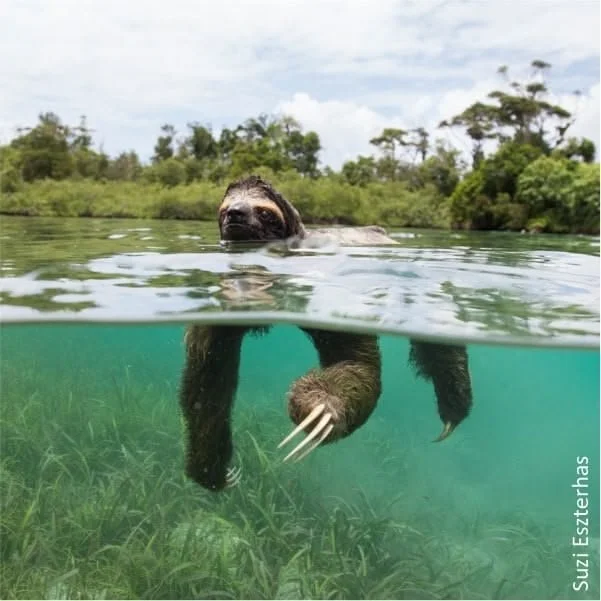
In these regions, vast rivers fragment the forest, leaving gaps in the canopy that could act as a barrier to tree-dwelling creatures. Monkeys are able to leap from branch to branch to cross over the rivers, but sloths cannot jump, and they must swim to reach new territories.
The sloth’s enormous stomach creates so much gas from digesting leaves that it acts as a giant flotation device. Their long necks allow them to keep their nose high above the water like a snorkel.
Since sloths can float and breathe easily, they do not need to paddle their limbs fast to stay afloat, and once in the water they can bob along and use their long arms to control the direction of travel. Pygmy sloths are the only sloth species known to swim in saltwater.
Activity Patterns
In our published research, “The behaviour and activity budgets of two sympatric sloths; Bradypus variegatus and Choloepus hoffmanni,” we discovered that:
Three-fingered sloths (Bradypus variegatus) sloths were inactive 85.5% of the time.
Two-fingered sloths (Choloepus hoffmanni) sloths were inactive 72.6% of the study duration.

Individual sloths displayed varying activity levels on different days, surprising us with the absence of synchronization within the same population. Contrary to previous beliefs that two-fingered sloths were strictly nocturnal, our findings revealed that they are actually cathemeral, being active during both day and night.
Jump To: Top, What is a Sloth?, Etymology and Naming, Phylogeny and Evolution, Taxonomy, Sloth Biology, Sloth Behaviors, Sloth Diet and Digestion, Reproduction and Lifespan, Habitat and Distribution, Survival Tactics, Sloth Conservation, Sloths and Human Relations, Sloths in Culture, Further Reading
Sloth Diet and Digestion
Food
Sloths are primarily folivores – meaning an animal who eats leaves. Wild sloths have sometimes been observed to eat fruit and seed pods from trees. Sloths in captivity are often fed fruits and vegetables, but it is not known if this is good for them.
Most animals don’t eat leaves because leaves have tough cellulose cell walls that are difficult to digest, have very few calories, and have a lot of toxins that can build up over time. Sloths combat this by mostly eating young leaves which contain lower levels of cellulose and toxins, and by rotating tree species in order to avoid a build-up of toxins.
Although sloths, in general, are known to feed from more than 90 different tree species, an individual sloth will rotate among approximately 7 to 12 favorite feeding trees – a strategy that prevents them from overeating any one kind of leaf.
Folivorous animals have the slowest metabolic rates in the land animal kingdom. Most folivores compensate for the low energy content of leaves by eating a large amount to make up for it: howler monkeys, which often share the same territories and even trees as sloths, eat 3 times as many leaves per kilogram of body weight as a sloth does!
Myth-busting – sloths make good neighbors to their fellow tree-dwelling animals and don’t eat birds or their eggs.

Sloths Drink Water
Sloths get most of the water they need from the foliage they consume, however both two-fingered and three-fingered sloths will drink from rivers, particularly on hot, dry days.
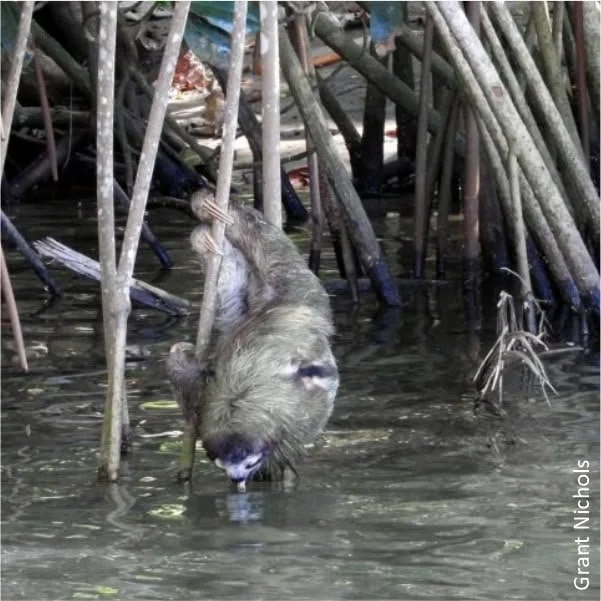
Geophagy
Two-fingered sloth will eat the soil and small stones from the forest floor. This is thought to help with digestion, provide extra salts and minerals and help neutralize toxins the sloth may have eaten.
Myth-busting – sloths don’t eat the algae and fungi growing on their fur!
Digestion
Sloths need to stay warm to digest their food. If they get too cold, sloths can die of starvation even on a full stomach. This is because the bacteria which breaks down the leaves will die if a sloth’s body temperature falls too low, leaving undigested leaves in their stomach which are unable to pass along or be regurgitated.
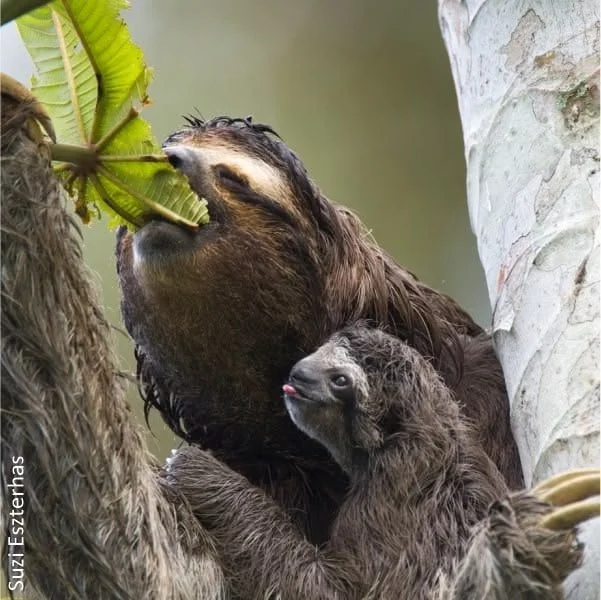
If this happens, the only way to save these animals is to replenish the gut bacteria. This can be done by giving the sloth probiotics or (in extreme cases) fecal matter from a healthy sloth – something that rescue centers fondly refer to as a “poop cocktail”.
It takes a sloth 28 days to digest one leaf! As a result, they have a constantly full stomach (which can account for up to 30% of their body mass) and therefore can’t eat very much on a daily basis.
In a study conducted by Dr. Rebecca Cliffe, it was discovered that sloths increase their levels of food intake on hotter days when they are better able to metabolize it. This is in stark contrast to most other mammals which tend to eat more on colder days to help maintain their body temperature. Sloths really do seem to do everything backwards!
Myth-busting – the leaves sloths eat do not contain psychoactive substances which makes them slow.
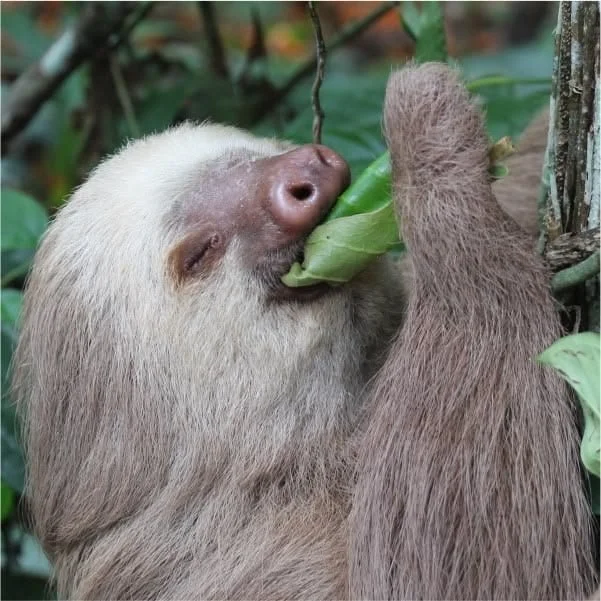
Jump To: Top, What is a Sloth?, Etymology and Naming, Phylogeny and Evolution, Taxonomy, Sloth Biology, Sloth Behaviors, Sloth Diet and Digestion, Reproduction and Lifespan, Habitat and Distribution, Survival Tactics, Sloth Conservation, Sloths and Human Relations, Sloths in Culture, Further Reading
Reproduction and Lifespan
Mating
Sloths reach sexual maturity when they’re between one and two years old. However, because they are slow movers without much energy to spare roaming around, finding a mate can be difficult.
Female three-fingered sloths will emit high-pitched vocalizations to attract the attention of males.
Two-fingered sloths do not vocalize. Instead, both males and females mark their scent by rubbing their anal glands against tree branches to send messages about their reproductive status.
Males will fight over access to the female. Sloths try to knock their opponent out of the tree by biting, swiping their claws, and holding on to each other.
The victor will then move on through the canopy to the female. He will stay with the female and mate frequently for several days, defending her against any other males who try to approach.
Female sloths are promiscuous and will mate with many males while in heat. Unlike almost everything else sloths do, the act of mating is quick and typically lasts less than a minute.
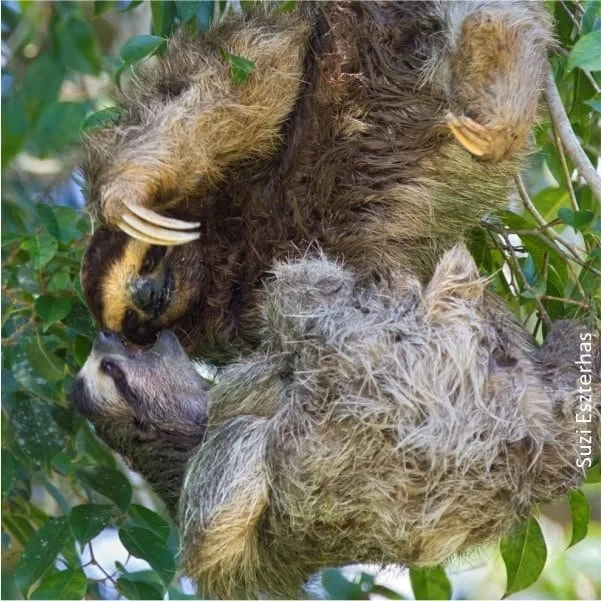
Pregnancy and Birth
A female sloth will have 1 baby approximately every 2 years. Two-fingered sloths will spend a full 12 months raising her baby. The period of maternal care is shorter for three-fingered sloths, averaging approximately 5 – 6 months.
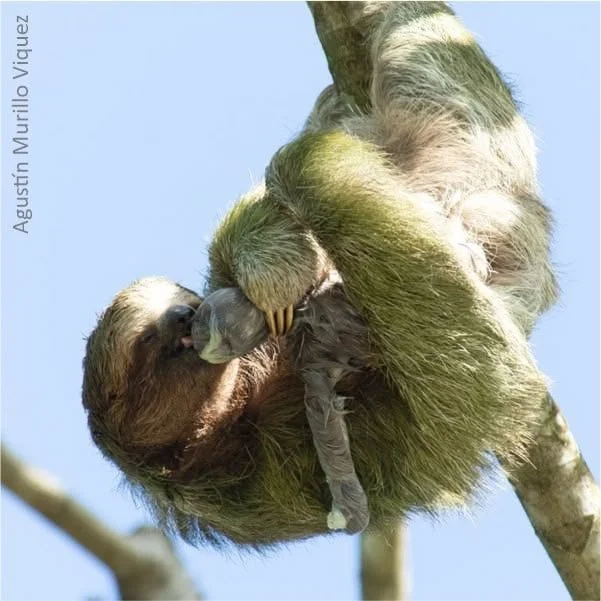
Sloths give birth to a single baby at a time. A two-fingered female sloth will give birth to a single baby after a gestation of 11.5 months, and it is thought that a three-fingered sloth is pregnant for approximately 6 months (although this is still unconfirmed by science).
Sloths have occasionally been known to give birth to twins, but there is only enough room on the female’s chest for one baby, so the weakest twin will be rejected. In cases where one sloth has been observed with two babies, this is usually the result of an older baby still hanging around after a female has given birth again.
When she is ready to give birth, the mother sloth will usually descend from high up in the canopy to a lower branch and give birth while hanging upside down.
This way if the newborn sloth falls to the ground it won’t fall very far, and the mother can climb down to retrieve her baby.
Male sloths are not involved in raising their young, so the female sloth will spend the next year of her life raising her baby alone.
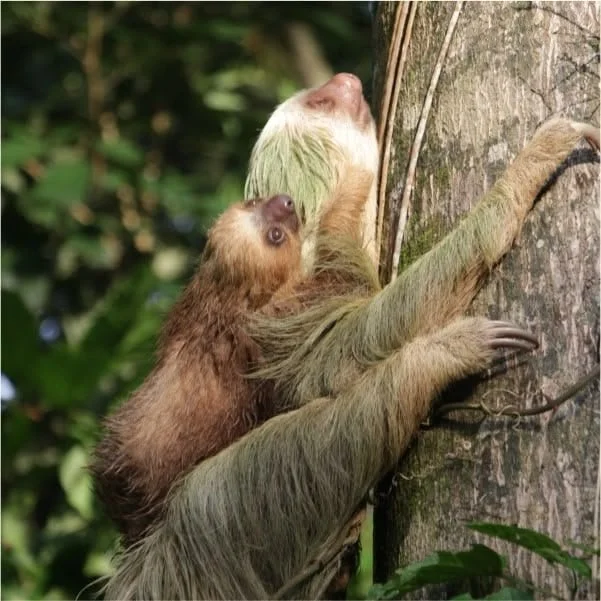
Baby Sloths
A baby sloth is born with their eyes open, their claws sharp, and their teeth fully formed. Most newborn sloths weigh between 300 to 500 grams (about 10 to 17 ounces), and three-fingered infants are usually smaller than two-fingered infants.
Immediately after birth the baby will instinctively crawl up toward the safety of its mother’s chest and cling to her fur. Once there, the baby will hold on for the next six months, nursing small amounts of milk throughout the day.
As early as one week old, baby sloths will begin sampling leaves from around their mother’s mouth in addition to drinking milk.
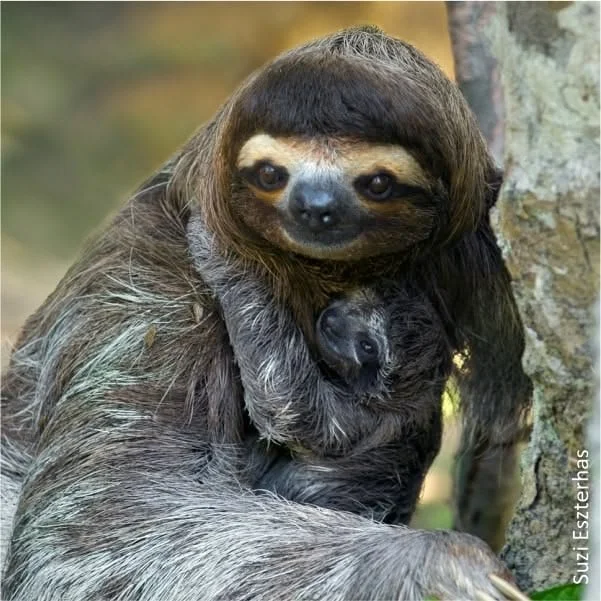
Interspecies Adoptions In Sloths
Although it is quite rare, there has been an unusual report in Costa Rica of a three-fingered sloth mother that adopted a two-fingered baby.
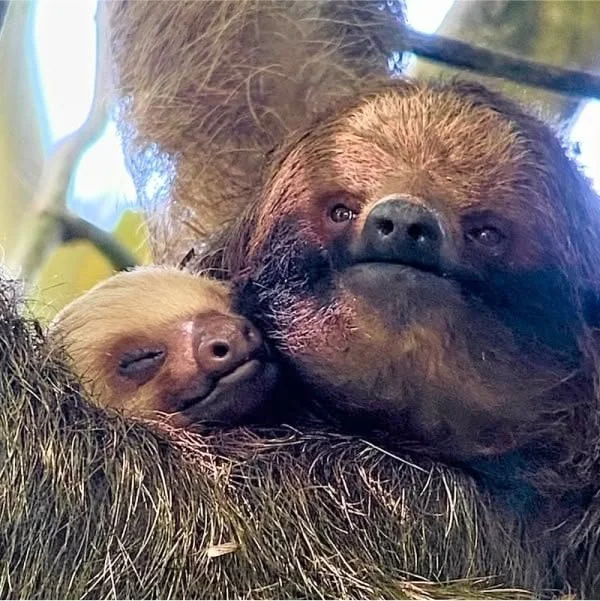
Lifespan
Nobody knows how long a wild sloth can live.
It is almost impossible to determine the age of a wild sloth. For most animals, their age can be estimated based on the length or wear and tear of their claws or teeth, but sloths are hypsodonts – their teeth and nails grow continuously throughout their lives, and are continuously worn down.
The only way to accurately age a wild sloth is through telomeric analysis, and in-depth studies of this kind have not yet been done.
Captive two-fingered (Choloepus) sloths are known to reach 40-50 years old, however, sloths were not bred in captivity until 50 years ago and so there has been little chance for any individual to exceed this figure.
The oldest known two-fingered sloth, named Paula, was 50 years old and lived at a zoo in Germany, while the oldest known three-fingered sloth, Buttercup, reached 27 years old at the Sloth Sanctuary of Costa Rica.
In captivity, sloths often have elevated stress levels, an excessively sedentary lifestyle, and eat an unnatural diet high in fructose.
This is because zoos do not typically have access to the new-growth tropical leaves that are a sloth’s natural diet and instead feed sloths fruit and vegetables they are not well adapted to eating.
These factors likely contribute to ill health and early mortality, therefore it seems likely that wild sloths may live longer in the wild than they do in captivity.
No one has ever followed a wild sloth from birth until death, and so any estimations on wild sloth longevity are only guesses.
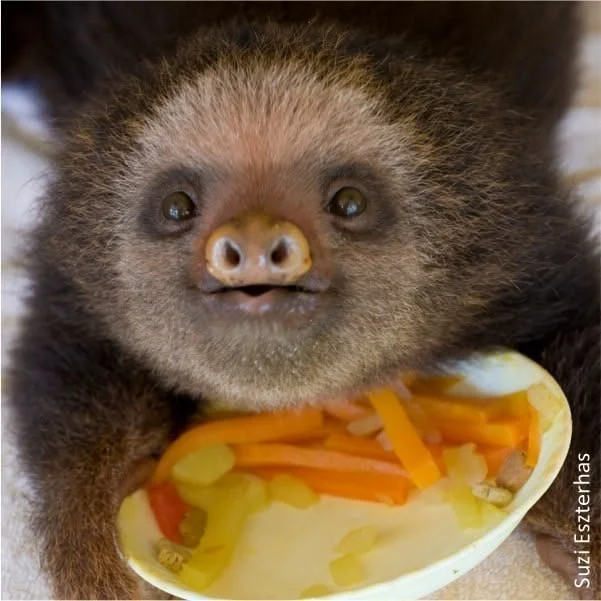
Jump To: Top, What is a Sloth?, Etymology and Naming, Phylogeny and Evolution, Taxonomy, Sloth Biology, Sloth Behaviors, Sloth Diet and Digestion, Reproduction and Lifespan, Habitat and Distribution, Survival Tactics, Sloth Conservation, Sloths and Human Relations, Sloths in Culture, Further Reading
Where Do Sloths Live? Habitat and Distribution
Sloths live in the rainforest ecosystems found throughout Central and South America.
All living species of sloths are arboreal mammals, found in the rainforest canopy. They require warm and humid conditions, and so are only found within 17° of the equator in South and Central America.
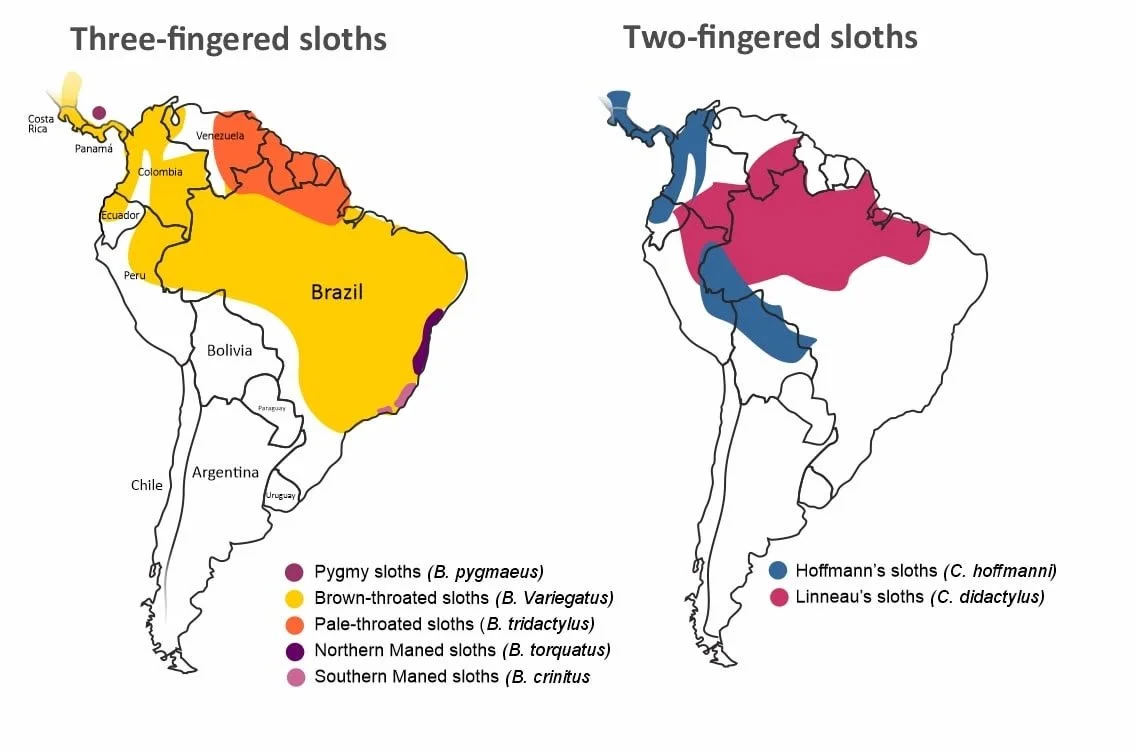
The persistence of sloths in high-altitude montane regions within this range is still poorly documented.
Sloths prefer undisturbed primary and secondary rainforests and are able to thrive in agroforestry ecosystems (for example, cacao farms). They can sometimes also be found in urban areas in regions where development has been recent and rapid.
Individual sloths are often uniquely adapted to survive in the area where they originate from in terms of habitat preference.
Jump To: Top, What is a Sloth?, Etymology and Naming, Phylogeny and Evolution, Taxonomy, Sloth Biology, Sloth Behaviors, Sloth Diet and Digestion, Reproduction and Lifespan, Habitat and Distribution, Survival Tactics, Sloth Conservation, Sloths and Human Relations, Sloths in Culture, Further Reading
Survival Tactics
Predators
Sloths’ primary natural predators are jaguars, ocelots, and harpy eagles. One would think that sloths would make easy prey for these jungle predators, however, millions of years of evolution have made sloths masters of disguise– their slow and silent movements blend in perfectly to the swaying branches of the jungle canopy.
Stealth
Sloths avoid predators that hunt by sight by moving very slowly and carefully. They are so slow that their movements fall below the threshold that triggers the attention of most predators.
It has been said that a gun could be fired next to a sloth’s head and the animal wouldn’t even turn around, leading to speculation that sloths are deaf.
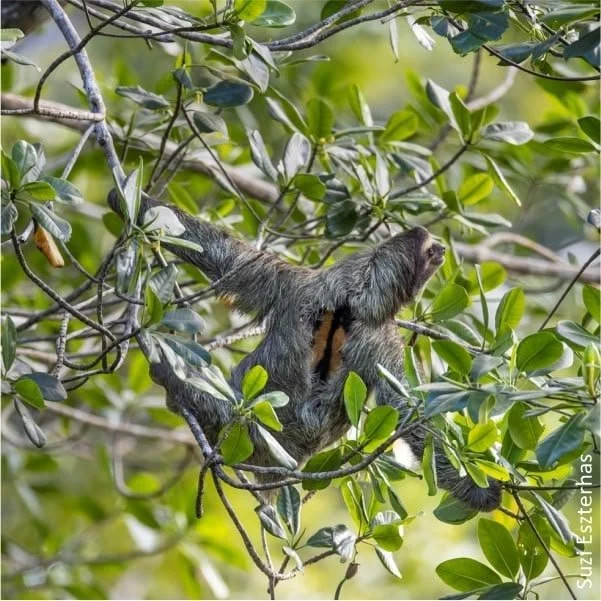
However, the sloth’s natural reaction, when faced with a threatening situation, is to stay completely still. They have evolved specifically to not break stealth by reacting to sudden loud sounds.
Odorless
Sloths avoid predators that hunt by scent by not producing any body odor of their own. Instead, the same algae and fungi that disguise sloths in the visual spectrum also make the sloth smell like a plant rather than an animal, helping them blend seamlessly into the jungle.

Defense
When threatened, two-fingered sloths can inflict a nasty bite and make their hair stand on end to appear larger (piloerection). Three-fingered sloths, however, rarely bite and cannot fluff their fur. To appear bigger they can only raise their arms above their head in a defensive posture and try to look more intimidating.
Camouflage
Their grey and brown fur helps them blend into the wood of the jungle trees, and their algae-coated fur makes them the only mammal in the world that looks green. This helps them blend into the leaves and vines in which they forage and sleep.
Invisible Under Infrared
As Poikilotherms the sloth’s temperature is very close to the surrounding environment at all times, confounding the pit organ that snakes use to “see” heat. This makes sloths difficult to detect across the entire visible spectrum, even the infrared.
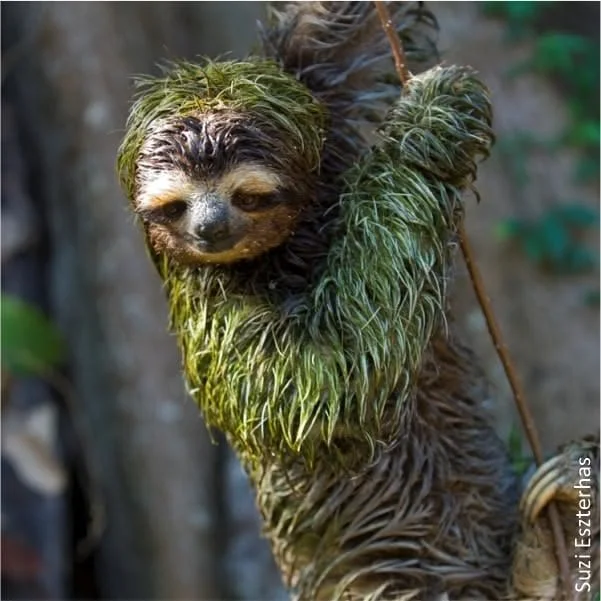
Jump To: Top, What is a Sloth?, Etymology and Naming, Phylogeny and Evolution, Taxonomy, Sloth Biology, Sloth Behaviors, Sloth Diet and Digestion, Reproduction and Lifespan, Habitat and Distribution, Survival Tactics, Sloth Conservation, Sloths and Human Relations, Sloths in Culture, Further Reading
Conservation
Habitat Loss and Genetics
For animals such as sloths that have limited dispersal abilities, habitat loss is extremely detrimental to their survival.
One of the major problems associated with habitat fragmentation is the inability of sloths to travel across forest gaps for breeding. Isolated from potential mates, this results in inbreeding, and consequently a rapid loss of genetic diversity.
Genetic diversity is one of the most important factors that determine the adaptability and survival of a species.
Unfortunately, warning signs of inbreeding are already becoming apparent in some populations, with a high number of baby sloths being born with birth defects such as missing fingers, albinism, and misshapen jaws and limbs.
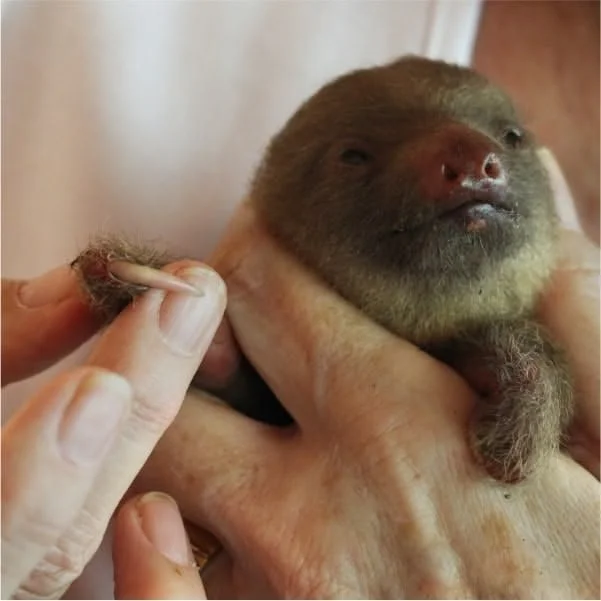
Endangered Sloths
Sloths are facing a long and sad list of threats including deforestation, power line electrocutions, dog attacks, poaching, road collisions, human cruelty, and global warming.
As a result, the Pygmy three-fingered sloths of Panama are now listed as critically endangered on the International Union for Conservation of Nature (IUCN) Red List, while the Maned sloths of Brazil have been listed as vulnerable.

Conservation in Costa Rica
There is much debate as to the number of individuals left in the wild, with published estimates ranging from one hundred up to several thousand.
Furthermore, the government of Costa Rica has recently declared two species of sloths as conservation concerns in the country due to populations being in “reduced and threatened states”.

Sloth parasites
A parasite is an organism that lives in or on a host and benefits by deriving nutrients at said host’s expense. A parasite differs from a symbiote in that a symbiote offers some benefit to the host in exchange.
There is very little research on parasitic infections in sloths. The majority of research that has been conducted has taken place on captive sloth populations, which live a very different lifestyle than wild sloths, with very different diets, vulnerabilities, and exposure.
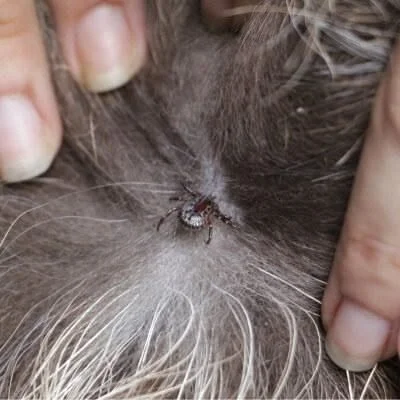
Jump To: Top, What is a Sloth?, Etymology and Naming, Phylogeny and Evolution, Taxonomy, Sloth Biology, Sloth Behaviors, Sloth Diet and Digestion, Reproduction and Lifespan, Habitat and Distribution, Survival Tactics, Sloth Conservation, Sloths and Human Relations, Sloths in Culture, Further Reading
Sloths and Human Relations
Urbanization
Sloths are creatures of habit. They do not have the ability to change their behavior in response to humans suddenly disturbing their habitat. When roads, power lines, and fruit plantations break up the continuous rainforest canopy that they rely on, sloths simply have nowhere left to go.
Roads, farms, towns, and cities now dominate the landscape, cutting the once continuous forest into smaller and more isolated segments. There is no way to escape the fact that one or two acres of rainforest land are cleared every single second. Due to their highly specialized lifestyle, sloths do not adapt well to such rapid environmental change.
When forests give way to towns, sloths sometimes try to stay around. One research project in the South Caribbean is studying how sloths adapt to urban environments and if humans and sloths can learn to live side by side in the same area.
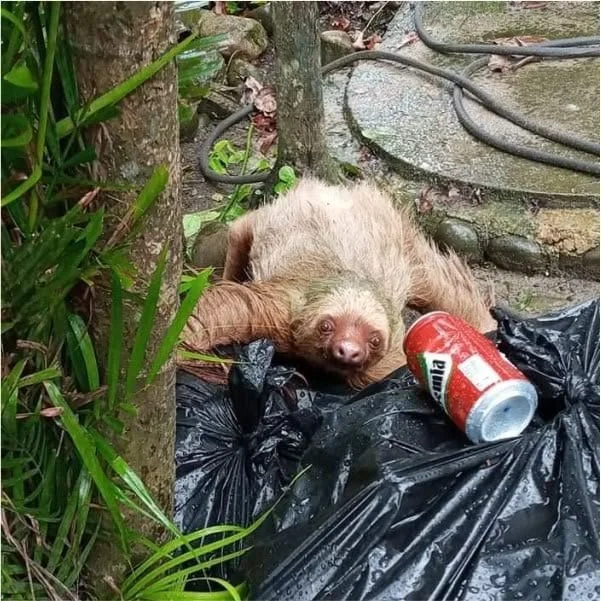
Sloth Myths and misinformation
Since sloths are very mysterious creatures with an odd appearance, this has led to a number of myths around them, both locally and abroad.
Stigmas that sloths carry contagious diseases, or that they are inept or stupid, can make them vulnerable to cruelty and mistreatment. Education is key to eliminating these myths so that sloths and humans can successfully coexist.
One long-standing myth comes from Douglas Adams: “Sloths are so stupid that they mistake their own arm for a tree branch and, grabbing it, fall”. Check out the following article for where this came from:

Sloth Pets and Captivity
Sloths make very poor pets. Their body language is different from most domesticated animals, making it difficult for humans to tell when a sloth is unhealthy or unhappy, and they are such mysterious creatures that even scientists are only beginning to understand what sloths need to survive and thrive.
The sad reality is that sloths sold as pets usually come from the wild. Even if the baby sloth was born in captivity, it is more than likely that the parents would have been taken from the wild several years earlier. Sloths are very slow to reproduce and as a result, the demand from the international pet trade is putting some wild populations at risk.
Once taken from their mother, it is very difficult to rehabilitate a baby sloth back to the wild. Sloths learn what to eat and inherit their feeding tree preferences from their mothers, which is one of the reasons why releasing hand-reared sloths into the wild is particularly difficult.
Even though they’re very adorable, do not buy a baby sloth as a pet, and do not patronize organizations that encourage people to hold and pet them! These organizations might mean well, but they do not understand sloths enough to provide for their welfare.
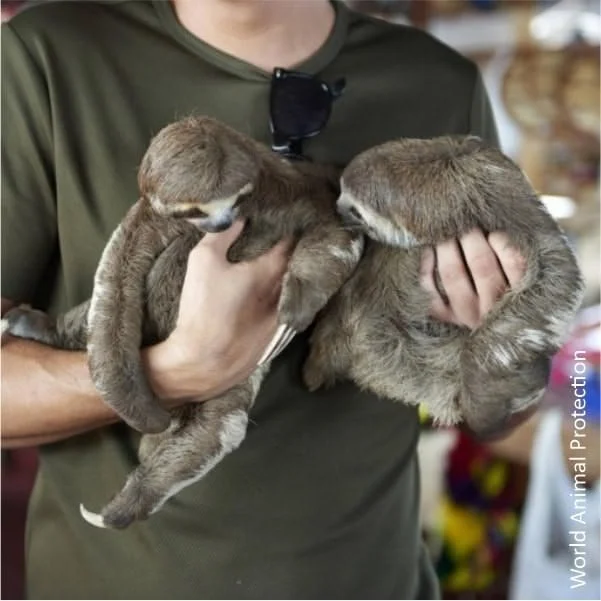
Research and Rescue
Thankfully, there are multiple organizations working tirelessly to ensure that all six sloth species will be around for generations to come. Rescue centers throughout South and Central America are taking in injured and orphaned sloths, carefully rehabilitating individuals, and learning how to return them safely to the wild.
Researchers from the Sloth Conservation Foundation are using genetic analysis to determine the exact cause of the many observed birth defects, to identify the populations most at risk of inbreeding and extinction, and to plant trees to increase habitat connectivity in the most vulnerable areas.
Rope bridges are being constructed across roads to reduce sloth traffic collisions and conservation groups are working with electricity companies to reduce the number of sloths falling victim to the power lines.

Jump To: Top, What is a Sloth?, Etymology and Naming, Phylogeny and Evolution, Taxonomy, Sloth Biology, Sloth Behaviors, Sloth Diet and Digestion, Reproduction and Lifespan, Habitat and Distribution, Survival Tactics, Sloth Conservation, Sloths and Human Relations, Sloths in Culture, Further Reading
Sloths in Culture
Sloth Quotes
“Every move a sloth makes is with purpose, which is more than most of us can say about 90% of the time.”
“The sloth lives his life upside down. He is perfectly comfortable that way. If the blood rushes to his head, nothing happens because there is nothing to work on.”
“Stuff your eyes with wonder,” he said, “live as if you’d drop dead in ten seconds. See the world. It’s more fantastic than any dream made or paid for in factories. Ask no guarantees, ask for no security, there never was such an animal. And if there were, it would be related to the great sloth which hangs upside down in a tree all day every day, sleeping its life away. To hell with that,” he said, “shake the tree and knock the great sloth down on his ass.”
― Ray Bradbury
“Sloths move at the speed of congressional debate but with greater deliberation and less noise.”
–P.J. O’Rourke
Famous Sloths from Movies.
Sid (Ice Age)
Brooke (Ice Age)
Flash Slothmore (Zootopia)
Priscilla Tripletoe (Zootopia)
Sakoth (Pokemon)
Vigoroth (Pokemon)
Slaking (Pokemon)
Snook (It’s a Big Big World)
Belt (The Croods)
Jump To: Top, What is a Sloth?, Etymology and Naming, Phylogeny and Evolution, Taxonomy, Sloth Biology, Sloth Behaviors, Sloth Diet and Digestion, Reproduction and Lifespan, Habitat and Distribution, Survival Tactics, Sloth Conservation, Sloths and Human Relations, Sloths in Culture, Further Reading
